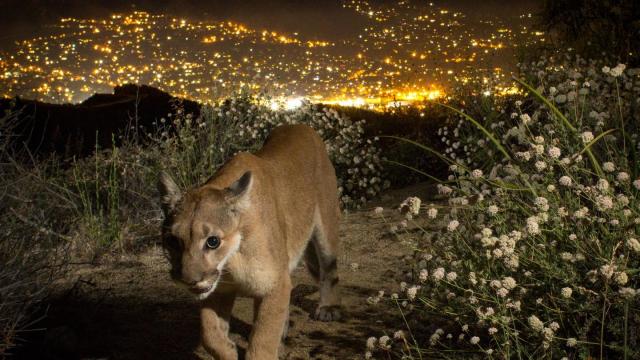Cougars have called California home long before humans have. In Los Angeles, however, urbanisation and human activity are driving nearby mountain populations toward possible extinction, according to a new study.
Published in the journal Ecological Applications Wednesday, the study uses 15 years’ worth of data, along with modelling and DNA analyses, to sound an alarm about the small populations of mountain lions in the Santa Ana and Santa Monica Mountains outside of Los Angeles. These cougars, which number roughly 15 in the Santa Monica Mountains and 30 in the Santa Ana, face an 11-21 per cent chance of extinction over the next fifty years.
“It’s important to recognise that they are predictions with the best data we have available,” Benson said. “No one can predict the future.”
That being said, this study paints a potentially scary future for these lions. The animals already suffer from a lack of genetic diversity as a result of isolation and habitat loss. Freeways, development, and agriculture prevent individuals from safely migrating into other areas and interbreeding to improve their genetic diversity. Plus, vehicles threaten these animals whenever they do travel: Car collisions are their leading cause of death.
In the long term, inbreeding is an existential threat.
However, the study found even a little bit more migration could help diversify the gene pool and, in turn, reduce the likelihood of extinction among the lions, especially the Santa Monica Mountains population. Models based on a DNA analysis of living mountain lions found that one immigrant a year brought the chance of extinction in the next 50 years down to 5 per cent. That’s due to an increase in genetic diversity and an increase in population size.
“The thing that’s exciting about these results to us is that when we model those slightly higher levels of immigration of mountain lions, trying to mimic potentially greater landscape connectivity in the future … accomplished by things like highway crossings, then we see that these populations are largely able to maintain their genetic diversity and the extinction probability is reduced,” Benson told Earther.
As Benson notes, the paper does suggest solutions like highway crossings. Sure, bringing in individual lions from elsewhere can help improve the genetic diversity in the short-term, but that won’t address their limited access to suitable habitat or the very real risk of fatal car accidents.
That wildlife crossing isn’t a pipedream, either: The Liberty Canyon Wildlife Crossing is a real proposal for a $85 million corridor over U.S. Route 101 that would connect Santa Monica Mountains to the Sierra Madre Mountain Range. That could begin construction by 2022 if funding is secured. A 2017 study showed that these bridges work; large mammals actually use them.
While the mountain lion species isn’t threatened or endangered in California at large, these two populations are vital to the local environment, argue the authors. Keystone predators like lions help ensure other large mammals, like deer, don’t take over and demolish vegetation. Just because the species exists somewhere in the U.S., its value in a specific location shouldn’t be diminished. That’s not cause to allow them to go extinct in these mountains.
“Yes, we would still have mountain lions if we lost them in these two populations, but we wouldn’t have them in those mountains,” Benson told Earther. “The ecosystems of those mountains would be changed as a result.”
There’s still time to safeguard a future for these lions. The question is whether leaders will step up to the challenge. If they can, all hope isn’t lost, Benson said.
“If we can conserve mountain lions in the greater Los Angeles area, we can probably do it in most landscapes.”
